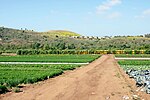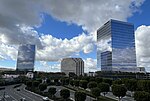Quail Hill, Irvine, California
Orange County, California geography stubsVillages of Irvine, California
Quail Hill is a village in the southern part of Irvine, Orange County, California. It is one of the seven communities that belong to the University area of the City of Irvine. The village is named for the characteristic rock formation that adjoins 600 acres (2.4 km2) of permanent open space. Located next to the 405 freeway, Quail Hill is close to major employment, entertainment and dining areas of the city. At the foot of Quail Hill there is the Quail Hill Loop Trail that provides public access to a natural surface trail.
Excerpt from the Wikipedia article Quail Hill, Irvine, California (License: CC BY-SA 3.0, Authors).Quail Hill, Irvine, California
Quail Hill Parkway, Irvine Quail Hill
Geographical coordinates (GPS) Address Nearby Places Show on map
Geographical coordinates (GPS)
| Latitude | Longitude |
|---|---|
| N 33.650404 ° | E -117.77481 ° |
Address
Quail Hill Parkway
Quail Hill Parkway
92603 Irvine, Quail Hill
California, United States
Open on Google Maps






